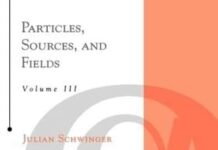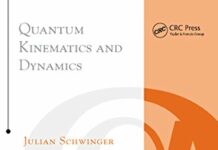
Ebook Info
- Published: 2003
- Number of pages: 448 pages
- Format: PDF
- File Size: 45.41 MB
- Authors: Julian Schwinger
Description
This monumental collection of thirty-four historical papers on quantum electrodynamics features contributions from the twentieth century’s leading physicists: Dyson, Fermi, Feynman, Foley, Heisenberg, Klein, Oppenheimer, Pauli, Weisskopf, and others. The papers were edited by Julian Schwinger, who won a Nobel Prize for his pioneering work in this very topic. Physicists, mathematicians, electromagnetic engineers, and students of the history and philosophy of science will find much of permanent value in these essays. Reports range from initial successes to the first signs of crisis, followed by the stimulus of experimental discovery and new triumphs that led to an unparalleled quantitative accord between theory and experiment. The compilation concludes with the vision of quantum electrodynamics as part of the larger subject of the theory of elementary particles, faced with fundamental problems as well as the future prospect of even more revolutionary discoveries.
User’s Reviews
Editorial Reviews: From the Back Cover This monumental collection of thirty-four historical papers on quantum electrodynamics features contributions from the twentieth century’s leading physicists: Dyson, Fermi, Feynman, Foley, Heisenberg, Klein, Oppenheimer, Pauli, Weisskopf, and others. The papers were edited by Julian Schwinger, who won a Nobel Prize for his pioneering work in this very topic. Physicists, mathematicians, electromagnetic engineers, and students of the history and philosophy of science will find much of permanent value in these essays. Reports range from initial successes to the first signs of crisis, followed by the stimulus of experimental discovery and new triumphs that led to an unparalleled quantitative accord between theory and experiment. The compilation concludes with the vision of quantum electrodynamics as part of the larger subject of the theory of elementary particles, faced with fundamental problems as well as the future prospect of even more revolutionary discoveries. About the Author One of the great 20th-century physicists, Julian Schwinger (1918–94) is best remembered for his work on the theory of quantum electrodynamics, the very topic of this text. He won the Nobel Prize in Physics in 1965, along with Richard Feynman and Shinichiro Tomonaga, for their work on quantum electrodynamics.
Reviews from Amazon users which were colected at the time this book was published on the website:
⭐I think some of the essay choices are questionable but it’s overall a nice resource to have, especially since a lot of the papers are old and difficult to find online (or formatted poorly when found).
⭐I am a graduate school student major in physics. Most of the major progress before 60’s are covered. It would be better if there is an overview or an introduction in the beginning of the book. Nevertheless, it’s still a good reference for a graduate student.
⭐There are mathematical path integrals most people don’t understand. Reporters ask three people why they won a Nobel Prize for the discovery of quantum electrodynamics and the people who wrote the papers in this book already knew this was worth high regard for thinkers who base visual memory on how we see things.
⭐Tomonaga: “most studying was done by looking up the original papers, one after the other.” (page 225, Story of Spin). Along with this volume, be sure to peruse three other resources: Schweber’s QED and the Men Who Made It, Miller’s Early Quantum Electrodynamics (for an English translation of papers 7 and 8, Dirac and Weisskopf) and Steven Weinberg’s chapter one in volume one of Quantum Theory of Fields.(1) Beginning with a ten-page preface and its conclusion, by Julian Schwinger: “The resulting appearance of divergences, and contradictions, serves to deny the basic measurement hypothesis.” That is a remarkable statement ! The source book begins with Paul Dirac’s paper (1927). A footnote in Dirac’s paper (page 18) refers to a paper by Max Born, I am unable to locate that paper ! Dirac mentions Max Born and probability earlier in an insightful manner (page 15). I do note that Dirac uses the phrase “relative a priori probability” at the conclusion of his beautiful 1932 paper: The Lagrangian in Quantum Mechanics.”(2) I will highlight Tomonaga’s paper (1946): On a Relativistically Invariant Formulation of the Quantum Theory of Wave Fields. Tomonaga begins by surveying Dirac’s “many-time formalism,” goes on to define functional-differentiation, then uses it as a generalization of Schrodinger’s equation. Expectation values, scalar products, projection operators and measurement, these in a paper which is a tour de force.(3) You do not get far without Feynman. Four of his papers are here (although the 1948 paper presented after the papers of 1949 and 1950). It is of interest that Feynman references Dirac’s second edition of his text Principles of Quantum Mechanics along with Heisenberg’s 1930 Principles of Quantum Theory. Suffice it to say, Feynman’s papers, Dirac’s textbook and Heisenberg’s Chicago lectures make compelling reading to this day. Feynman writes: “the use of the Hamiltonian forces one to choose the field viewpoint rather than the interaction viewpoint.” (page 238, 1949). Appendix A of Feynman’s 1950 paper describes “an alternative to the formulation of second quantization.” (page 270).(4) Paper # 7, Theory of the Positron, here Dirac confronts the issue of ‘negative energy’ and ‘holes.’ Charge renormalization brought to prominence. Paper # 8, Weisskopf, offers continuation of that theme: negative-energy-states. Of interest is utilization of Euler sum formulas, Bernoulli numbers and density matrix. The papers are presented in translation in Miller’s volume.(5) Julian Schwinger is represented in seven of his papers (Schwinger is also editor). Now, of Schwinger’s two papers, here 14 and 17, Jauch and Rohrlich write: “these calculations contain two errors…” (Theory of Photons and Electrons, 1955, footnote, page 339). Allowing these errors, Jauch and Rohrlich remind us that Schwinger still got it right ! Freeman Dyson writes of paper 17: “outstandingly difficult to read.” (Dyson, page 158, Advanced Quantum Mechanics).(6) Fermi’s 1930 paper (Nota #2, in Italian) is mentioned by Silvan Schweber (in pages 73-76). Schweber writes that Fermi desired to simplify the quantization procedure of Dirac. Now, continue with his Reviews of Modern Physics article: Quantum Theory of Radiation (1932). Fermi is always worthy of contemplation.(7) Pauli’s 1940 paper is here, The Connection Between Spin and Statistics. His footnote makes reference to Van der Waerden’s Methods of Group Theory in Quantum Mechanics (1932). Pauli’s conclusion: “the connection between spin and statistics is one of the most important applications of the special theory of relativity.”(8) Concluding: Julian Schwinger edits 34 papers (Languages: 29 English, 1 French, 3 German, 1 Italian).If perusal of original documents is to your liking, you will enjoy dipping into this resource. A monograph by Jauch and Rohrlich replicates much from this time-frame in textbook form. Silvan Schweber writes: “I am not able to do justice to Tomonaga’s story.” (1994, page 249). If for no other reason than to “do justice” to Tomonaga, get this reprint book ! One can hardly fail to note the brilliance of Dyson, and as Steven Weinberg has written: “with the publication of Dyson’s papers, there was at last a general and systematic formalism that physicists could easily learn to use, and that would provide a common language for the subsequent applications of quantum field theory to the problems of physics.”(1995, Quantum Theory of Fields, volume one, page 37).
⭐This is a collection of fundamental papers on quantum electrodynamics, starting from the very first, by Dirac, and going to the paper by G. Kallen showing that at least one of the renormalization constants is infinite (this paper has been called “poetry in quantum field theory”). This is invaluable for the historian, but much more, I think, for the student and, yet more, for the researcher. These days the students learn these things in classroom. This is all right, but it is only in the good pioneering papers that you find the reasons for the choices made, motivations for treating the problem and a full explanation of what is being done and why it would be wrong to follow that other, seemingly much more natural, way. As examples, you’ll find here four of the greatest papers by Feynman. If you think Feynman wrote well because you read his popular books, wait till you read his scientific works! There is also the monumental paper by Dyson, where the founding pape! rs of Tomonaga, Schwinger and Feynman are made to coalesce into the beautiful formulation that, afterwards, was repeated in all textbooks. My favorite paper is the great “On gauge invariance and vacuum polarization”, by Julian Schwinger, a masterpiece of insight, style, and incredible virtuosity, a paper that still gives rise to original research. The preface by Schwinger is a must for understanding the origin and early development of our main tool in theoretical physics: quantum field theory.
⭐The book contains the original papers on quantum electrodynamics. It is is fascinating to see how the minds of these physicists work, in particular, since the authors include several Nobel Price winners. The difference between Schwinger and Feynmann is the very interesting, one is mathematical and the other is intuitive, but both were completely correct! Dyson’s paper where he shows that both theories are the same is a classic. An excellent reference for learning QED and for the history.
⭐Un excelente recopilación de los artículos clave de la electrodinámica cuántica y una introduccción muy clara de Julian Schwinger, uno de los padres de la teoría.It looks like a very good selection of original papers on Quantum Electrodynamics.
⭐Diracによる、輻射を量子論的に扱う仕事(1927年)に端を発する量子電磁力学(QED)は、現在では非常に精度よく実験データを説明できる理論として確立しています。しかし、よく知られていることかもしれませんが、QEDが現在の地位を獲得するまでには1.理論の相対論的不変性が不明瞭であること2.摂動計算を行うと、計算結果が発散することの2つが、最大の障害として立ちはだかっていました。この論文集には、以上の障害が取り除かれる以前の不満足(?)なQEDの定式化の過程および、現在の形に仕上がっていくまでの過程で多大な寄与を及ぼした代表的な論文(全部で34篇)が収められています。なかでも・QEDに先鞭をつけた、Diracの輻射の量子論の論文・現在知られているQEDの理論形式を作り上げた、Tomonaga、Schwinger、Feynmanの論文・Tomonaga-Schwinger理論とFeynman理論が等価であることを示したDysonの論文・QEDがすべての次数で繰り込み可能であることを(数学的に厳密ではないが)示したDysonの論文・DiracによるLagrange形式での量子論の構築、およびそれを基にしたFeynmanの経路積分の論文は、一読の価値があると思います。また、理論に関する論文だけでなく、異常磁気モーメントやラムシフトの測定などの実験方面の論文までも収められています。QEDの歴史を知るという意味でも、非常に重要な文献であると思います。※論文の一部に、ドイツ語・フランス語・イタリア語で書かれたものがあります。
⭐
Keywords
Free Download Selected Papers on Quantum Electrodynamics in PDF format
Selected Papers on Quantum Electrodynamics PDF Free Download
Download Selected Papers on Quantum Electrodynamics 2003 PDF Free
Selected Papers on Quantum Electrodynamics 2003 PDF Free Download
Download Selected Papers on Quantum Electrodynamics PDF
Free Download Ebook Selected Papers on Quantum Electrodynamics





